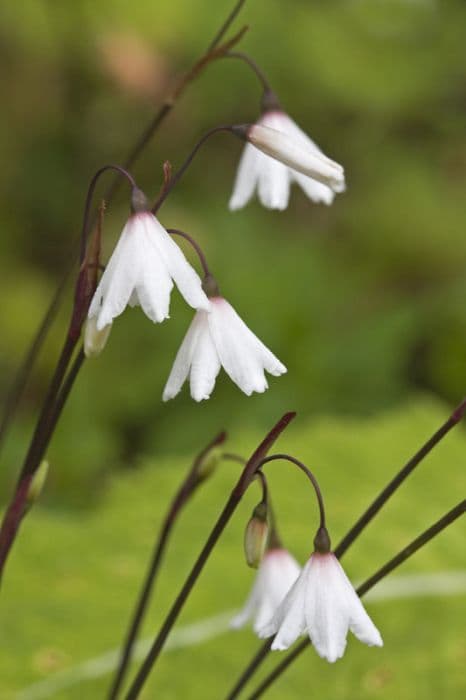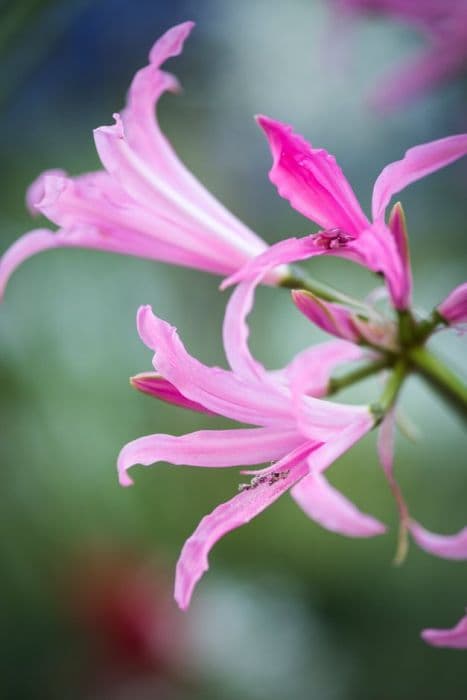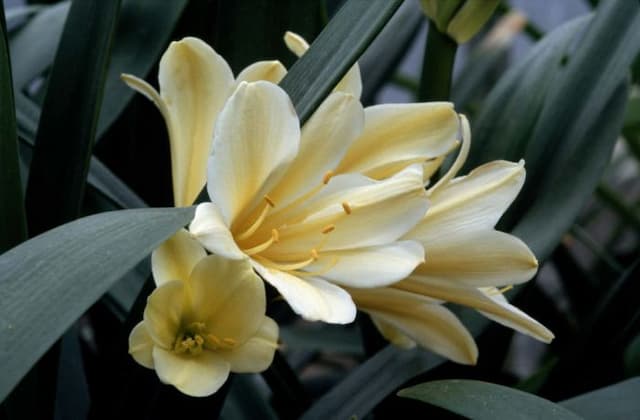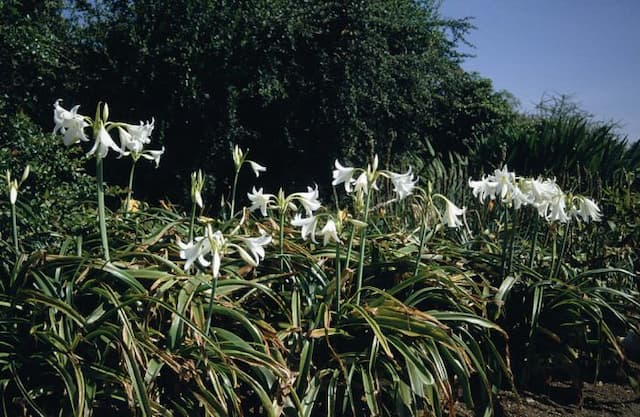Daffodil Narcissus 'Great Gatsby' (2)

ABOUT
The plant in question is a variety of daffodil known as 'Great Gatsby'. This plant boasts an attractive and ornamental appearance characteristic of daffodils. It has sturdy stems that support the weight of the flowers. The blooms of the 'Great Gatsby' are distinctive with their trumpet-like shape, which is a hallmark of daffodils. The flowers typically feature a central corona surrounded by a ring of petals. The 'Great Gatsby' daffodil is noted for its color palette, which includes a combination of bright and cheerful colors that make it stand out in any garden setting. The petals can range from pure white to a soft yellow, while the trumpet may exhibit a stronger, more vivid hue, possibly a deeper golden or even a contrasting color like orange or pink, adding to its eye-catching appearance. The foliage of this daffodil typically emerges as slender, green leaves that may have a slightly bluish or grayish tinge. These leaves are often described as sword-like because of their linear and pointed shape. They are arranged in a way that nicely complements and balances the visual focus on the striking flowers. Overall, the 'Great Gatsby' daffodil has a very distinctive and appealing look that signals the arrival of spring. With its delightful blossoms and fresh green foliage, this plant is often used in gardens to create a display of bright and uplifting color during the blooming season.
About this plant
 Names
NamesFamily
Amaryllidaceae
Synonyms
Daffodil, Jonquil, Narcissus
Common names
Narcissus 'Great Gatsby'
 Toxicity
ToxicityTo humans
Daffodil, including the 'Great Gatsby' variety, contains toxic alkaloids such as lycorine. If any part of the plant is ingested, it can cause symptoms like nausea, vomiting, diarrhea, and abdominal pain. In severe cases, daffodil ingestion can lead to cardiac arrhythmias, low blood pressure, tremors, and seizures. Handling the bulbs can cause dermatitis in some people.
To pets
Daffodil is toxic to pets, containing harmful compounds such as lycorine. If a pet ingests any part of a daffodil, symptoms including vomiting, salivation, diarrhea, abdominal pain, and potentially heart rhythm anomalies or respiratory depression can occur. The bulb is the most poisonous part, and severe cases of poisoning could be life-threatening.
 Characteristics
CharacteristicsLife cycle
Perennials
Foliage type
Deciduous
Color of leaves
Green
Flower color
White
Height
1-1.5 feet (30-45 cm)
Spread
0.5-1 feet (15-30 cm)
Plant type
Bulb
Hardiness zones
3-9
Native area
Western Europe
Benefits
 General Benefits
General Benefits- Enhances Garden Aesthetics: The Narcissus 'Great Gatsby' adds a striking visual element to gardens with its large, double flowers and vibrant yellow and white colors.
- Easy to Grow: This plant is known for being robust and easy to cultivate, making it suitable for gardeners of all skill levels.
- Attracts Pollinators: The blooms attract bees and other beneficial pollinators, which are essential for the health of the garden ecosystem.
- Long Blooming Period: Offers a prolonged blooming time in spring, providing color and interest over an extended period.
- Naturalizing: The bulbs can naturalize over time, multiplying and spreading to fill out the landscape without needing replanting.
- Cut Flower Usage: The blossoms are excellent for creating ornamental floral arrangements.
- Deer Resistance: Narcissus plants are generally resistant to deer, which helps to prevent garden damage in areas with deer populations.
- Springtime Signifier: The bloom of daffodils, including the 'Great Gatsby', is often seen as a herald of spring, bringing a sense of renewal to the garden.
 Medical Properties
Medical PropertiesThis plant is not used for medical purposes.
 Air-purifying Qualities
Air-purifying QualitiesThis plant is not specifically known for air purifying qualities.
 Other Uses
Other Uses- Narcissus 'Great Gatsby' can be used in cut flower arrangements, providing a visually stunning and aromatically pleasing addition to bouquets.
- The bulbs of narcissus can be used for a natural dye, giving fabric a vibrant yellow hue that comes from the pigments in the petals.
- Floral waters can be distilled from narcissus flowers, often used for their fragrance in perfumery and aromatherapy practices.
- Narcissus flowers are sometimes incorporated into potpourri mixes, lending their scent to the combination of dried petals and spices.
- The plant can play a role in companion planting, helping deter certain pests due to its toxicity from gardens and fields.
- As an educational tool, narcissus can be used in botany and horticulture programs to teach about bulbous plant growth and care.
- Narcissus 'Great Gatsby' can be a source of inspiration for artists and photographers due to its striking appearance and vibrant color.
- In large plantings, narcissus can be effective for erosion control because their root systems help hold the soil in place.
- The distinctive look of narcissus can be used in thematic gardens, such as 1920s-inspired landscapes, to evoke a particular historical period or literary reference.
- Narcissus flowers can be used in floating centerpieces for events, where the blooms are set atop water in bowls or vases for decoration.
Interesting Facts
 Feng Shui
Feng ShuiThe daffodil, which is the most common common name for Narcissus 'Great Gatsby', is associated with good fortune in Feng Shui. It can be used to attract wealth by placing it in the wealth corner of your home or office, which is typically the southeast. Its blossoming flowers symbolize the coming of new opportunities and are thought to bring a fresh start or renewal of energy.
 Zodiac Sign Compitability
Zodiac Sign CompitabilityThe daffodil is not used in astrology practice.
 Plant Symbolism
Plant Symbolism- Self-love: Named after the mythological character Narcissus, who fell in love with his own reflection, this flower symbolizes self-love and narcissism.
- Renewal and New Beginnings: Since it's one of the first flowers to bloom in spring, the daffodil often represents renewal and the coming of a new start or beginning.
- Vanity: Given the story of Narcissus, daffodils can also symbolize excessive self-love and vanity.
- Prosperity: In some cultures, daffodils are seen as symbols of wealth and success, possibly because of their bright blooming as a sign of the richness of spring.
- Uncertainty: Despite their positive associations, daffodils can also represent uncertainty or unrequited love, echoing the unfulfilled desires of Narcissus.
- Hope: The bright yellow hue of daffodils is often linked with hope and optimism, suggesting the overcoming of challenges or difficulties.
 Water
WaterDaffodils, including the Narcissus 'Great Gatsby', prefer evenly moist soil, especially when they are actively growing in the spring. During this period, water them thoroughly once a week, providing about 1 gallon for every 2 square feet of soil if there hasn't been sufficient rainfall. After they finish blooming and the foliage starts to die back, reduce watering frequency as the bulbs enter dormancy. It's crucial not to overwater, as daffodils are prone to rot in waterlogged soil. Ensure that your daffodils are in well-drained soil to prevent excess moisture from accumulating.
 Light
LightDaffodils like the Narcissus 'Great Gatsby' thrive in full to partial sunlight. The ideal spot is where they can enjoy at least six hours of direct sunlight a day. Avoid deeply shaded areas as this can affect their blooming. Lighter shade may be tolerated but full sun is best for vigorous growth and optimal flowering.
 Temperature
TemperatureDaffodils, such as the Narcissus 'Great Gatsby', perform best in temperatures that range from about 50 to 70 degrees Fahrenheit. They can survive brief periods of colder weather, down to at least 20 degrees Fahrenheit, and can tolerate up to 80 degrees during their growth period. However, prolonged exposure to temperatures outside of 50-70 degrees Fahrenheit may harm the plant or inhibit flowering.
 Pruning
PruningDaffodils like Narcissus 'Great Gatsby' do not require extensive pruning, but deadheading spent flowers after blooming is beneficial. Remove the flower heads to prevent seed pod formation, redirecting energy to the bulb. Cutting back the foliage is only recommended once it has yellowed and died back naturally, usually about six weeks after flowering. Avoid removing leaves while they are still green as they are replenishing the bulb for the next season.
 Cleaning
CleaningNot needed
 Soil
SoilDaffodil 'Great Gatsby' thrives in well-draining soil with a pH of 6.0 to 7.0. A good soil mix might contain equal parts of loam, sand, and organic compost which ensures good drainage while providing sufficient nutrients. Amend with bone meal for root and bulb development.
 Repotting
RepottingDaffodils, such as 'Great Gatsby,' generally do not need frequent repotting and can be left undisturbed for several years. They should be repotted only when they become overcrowded, usually every 3 to 5 years, to maintain vigor.
 Humidity & Misting
Humidity & MistingDaffodils, including 'Great Gatsby,' are not particularly humidity-sensitive and do well in average ambient humidity levels. Aim for moderate humidity without the air being too dry or too moist.
 Suitable locations
Suitable locationsIndoor
Ensure bright, indirect light, and cool temperatures indoors.
Outdoor
Plant bulbs in fall, full to partial sun, cool soil.
Hardiness zone
3-9 USDA
 Life cycle
Life cycleThe Narcissus 'Great Gatsby', commonly known as the Daffodil, starts its life cycle with a dormant bulb which typically remains underground during the winter months. As temperatures rise in the spring, the bulb breaks dormancy and sends up green shoots, followed by the development of one or more flowers characterized by their white petals and a central trumpet-shaped corona. After flowering, the plant undergoes pollination, which if successful, will lead to the formation of a seed pod. Once the seeds mature, the pod dries and opens, releasing the seeds into the surrounding environment. The foliage then begins to die back, and the plant reenters a period of dormancy, where it will remain until the next growing season. The cycle repeats annually with bulbs potentially dividing to produce new bulbs, contributing to the spread and perpetuation of the Daffodil.
 Propogation
PropogationPropogation time
Spring-Early Summer
The Narcissus 'Great Gatsby', commonly known as the Great Gatsby daffodil, is typically propagated by bulb division. The best time to divide and plant daffodil bulbs is in the late summer to fall, after the foliage has died back and the bulbs have gone dormant. To propagate by division, carefully dig up the daffodil clumps and separate the bulbs by gently pulling them apart. Each bulb should have a portion of the base and some roots attached. Replant the bulbs immediately at a depth three times the height of the bulb, which is usually about 6 to 8 inches (15 to 20 centimeters), in well-draining soil with exposure to full or partial sunlight. Water the newly planted bulbs well to help establish them. This method helps to rejuvenate crowded clumps and encourages more vigorous blooming in the following spring.









